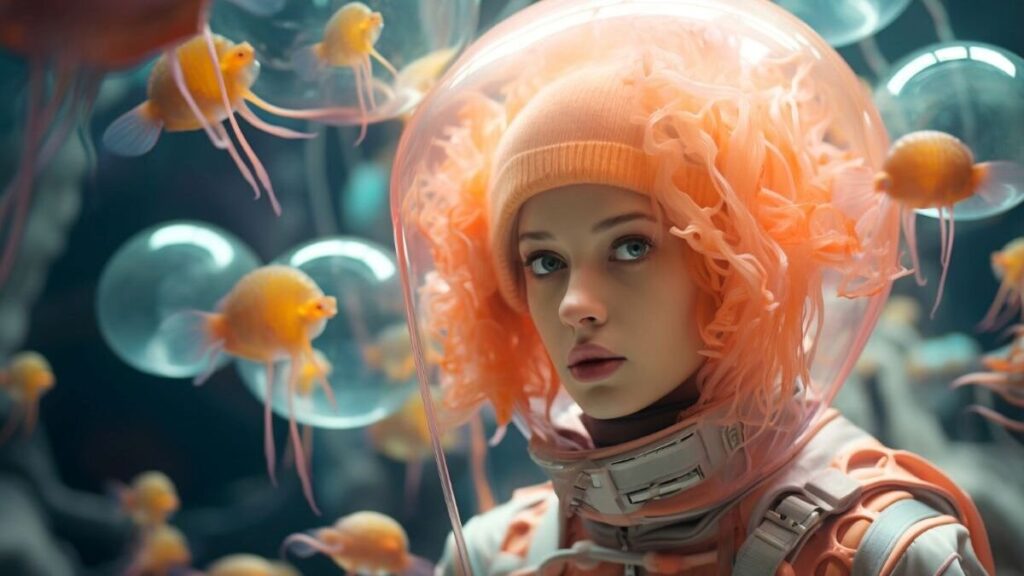Introduction – The Mystery of Machine Emotions
Imagine you’re venting to a chatbot after a rough day, and it replies with, “That sounds tough, I’m here for you.” It feels comforting. But here’s the kicker — does the machine actually care, or is it just mimicking empathy? As AI develops further, the query “Is it possible for AI create emotion?“ isn’t just a sci-fi curiosity anymore — it’s a present-day debate.
- Introduction – The Mystery of Machine Emotions
- Truth #1 – AI Doesn't Feel, It Simulates
- Truth #2 – AI Learns From Emotional Data
- Truth #3 – AI Is Getting Better at Reading Emotions
- Truth #4 – Emotional AI Is Already Among Us
- Truth #5 – AI Create Emotion to Influence You
- Truth #6 – Emotional Machines Lack Consciousness
- Truth #7 – AI Can Trigger Emotional Responses in Humans
- Truth #8 – AI Emotion Isn't Universal
- Truth #9 – Some AI Are Designed to Feel
- Truth #10 – The Future: Can AI Truly Feel One Day?
- Conclusion – Feeling the Future
We’re now living in a world where AI doesn’t just follow commands — it talks, reacts, and even “understands” how you feel. Or does it? With chatbots like ChatGPT and emotional AI like Replika or Kuki, we’re in new emotional territory. People are laughing, crying, and even falling in love with bots. The line between feeling and faking is getting blurry, and it’s time we face the truth.
Whether you’re an AI skeptic or someone who swears their smart assistant “gets them,” this article dives into 10 shocking truths behind machine feelings. You’ll discover how artificial intelligence processes emotions, what it can and can’t do, and the real reason companies are racing to make machines “feel.”
Truth #1 – AI Doesn’t Feel, It Simulates
It is important to state right away that machines are not human. They don’t get butterflies, goosebumps, or that warm, fuzzy feeling when they see a cute puppy. So when we ask, “Can AI create emotion?” what we’re really talking about is simulation, not sensation.
AI doesn’t feel — it acts like it does. That’s a big difference. It’s a magician’s trick, not a miracle. Think of it like a well-rehearsed actor playing a role. The actors might cry on cue, but they’re not actually heartbroken. Similarly, when AI says, “I understand how you feel,” it’s mimicking what it’s been trained to recognize, not genuinely empathizing.
An example? Customer support bots. They’re programmed to reply with phrases like, “I’m sorry for your frustration,” not because they care but because they’ve been trained on thousands of conversations where that’s the expected response. The goal is to calm you down and create trust — a useful illusion, but an illusion nonetheless.
So, no, AI can’t sit in your pain or celebrate your joy. But it can mirror those reactions so well that it feels real. That’s where the real power — and potential danger — lies.
Truth #2 – AI Learns From Emotional Data
Here’s where things get a little spooky. AI doesn’t just respond emotionally — it’s trained on our emotions. Through mountains of data from texts, videos, social media posts, and even voice recordings, AI learns patterns in how we express joy, sadness, anger, and more.
Let’s say you post, “I’m so sad, my dog just passed away 😢.” That’s data. Multiply that by billions of posts and comments, and AI starts to understand what sadness looks like online. It learns that people use words like “miss,” “heartbroken,” and emojis like 😔 or 💔 when grieving. Over time, it begins to associate those patterns with emotional states.
But can it really understand them? Not in a human way. Humans feel sadness because we’ve experienced loss. Machines process it as a data set, a collection of words and tones that fit into an algorithm. That’s the core difference — comprehension without connection.
Yet it’s impressive — and a little eerie — how well it works. Replika, for instance, is an AI friend that learns how to talk to you based on your emotions. It adjusts the more you talk to it. People report feeling deeply understood. Some even say, “My bot knows me better than my therapist.” That’s a bold statement, but it shows how powerful emotional data training can be.
Still, we can’t forget — AI create emotion only by reflecting what we teach it. It’s a mirror, not a mind.
Truth #3 – AI Is Getting Better at Reading Emotions
Ever had your phone suggest a sad playlist when you’re feeling low? That’s not magic — that’s emotional AI at work. Today’s AI can analyze tone of voice, facial expressions, and even text sentiment to figure out how you’re feeling. In fact, it might even spot your mood faster than your best friend.
Emotion recognition technology is being pioneered by companies such as Microsoft and Affectiva. Using webcams, microphones, and machine learning, they teach AI to detect whether someone is angry, happy, scared, or indifferent. One jaw-dropping example? Some recruitment platforms now use AI to analyze your facial expressions during interviews to assess “emotional intelligence.” Creepy or cool?
In healthcare, AI is being used to monitor patients’ emotions to detect early signs of depression or anxiety. Imagine your smartwatch nudging you when it thinks you’re spiraling — that’s emotional AI stepping in like a digital therapist.
What’s more mind-blowing is that AI create emotion recognition systems that can detect micro-expressions — tiny, split-second facial changes humans often miss. It’s Sherlock Holmes on steroids. While humans might miss subtle cues, AI is watching, learning, and tagging everything with remarkable accuracy.
That said, just because AI can read your emotions doesn’t mean it understands them. But that doesn’t stop people from reacting emotionally to machines that seem to “get” them, and that’s where the illusion becomes powerful.
Truth #4 – Emotional AI Is Already Among Us
Emotional AI may seem like a thing of the future to you. News flash: it’s already here — and you’re probably using it daily. Smart assistants like Alexa or Siri? They’re not just answering questions — they’re learning how you feel when you ask them.
Open your email. Notice how Gmail suggests responses like “Thanks for your help 😊”? It’s emotionally intelligent auto-text, not just auto-text. It’s been trained to suggest emotionally appropriate replies, nudging you to communicate more warmly.
Then there are the customer service bots that respond with “I totally understand your frustration” and change their tone based on your mood. Or your Netflix recommendations subtly shift based on whether you watched a comedy or a tearjerker last night.
In education, AI tutors adjust difficulty levels and offer motivational prompts when they sense a student is frustrated. And in therapy apps like Woebot, the system offers conversational support by identifying emotional patterns in your chat, often in real time.
It’s all designed to make us feel like the machine “gets” us. And when AI create emotional responses that feel tailored and caring, we start to treat it like a real companion. That’s the silent revolution happening under our noses.
Truth #5 – AI Create Emotion to Influence You
Here’s the uncomfortable truth: emotional AI isn’t just about understanding you — it’s about influencing you. That comforting chatbot? It might be nudging you to buy something, click something, or stay longer on a platform.
Companies are already using emotional data to craft personalized ads. Say you’re feeling sad — your favorite store’s app might suggest a “treat yourself” discount. That’s AI create emotion strategies being used to trigger your wallet.
In politics, AI-powered sentiment analysis tools are being used to shape messaging that hits emotional buttons. Ever feel like an ad just “got you”? That’s no accident. AI helped it get under your skin.
But with this power comes a huge ethical dilemma. If machines can tap into our emotional vulnerabilities, where’s the line? How do we protect ourselves from manipulation that feels like comfort?
We’re in uncharted territory — and it’s never been more important to understand what emotional AI is really doing behind the scenes.
Truth #6 – Emotional Machines Lack Consciousness
Let’s clear up another common misconception. Machines are not necessarily conscious just because they appear to be emotive. In fact, no matter how advanced they become, they still lack what makes emotions real for humans: self-awareness, context, and memory of experience.
Think about it. When you feel something — joy, grief, embarrassment — it’s tied to your identity, your past, and your ability to reflect. You remember that awkward moment in 6th grade or the first time you fell in love. Human emotions are intricate, complicated, and very individualized. Robots? Not so much.
When we talk about how AI create emotion, what’s actually happening is data analysis and response generation. AI doesn’t know it’s feeling anything. It’s simply recognizing patterns and selecting responses that match those patterns. There’s no internal monologue, no soul-searching, no sense of self behind the curtain.
That’s a critical difference. We anthropomorphize machines — it’s in our nature. When a robot pet cuddles, we assume affection. When a chatbot says, “I’m proud of you,” we feel validated. But the machine is just running code, no matter how convincing the output is.
This doesn’t mean emotional AI can’t be useful. On the contrary, it can help in mental health, customer service, and even education. But let’s not fool ourselves into believing it feels what we feel. Until machines can reflect, question, and relate their experiences, true emotion remains a uniquely human experience.
Truth #7 – AI Can Trigger Emotional Responses in Humans
Here’s where things get really interesting — and a little emotional. While machines may not feel, they can make us feel. In fact, some of the strongest reactions humans have today are caused by AI-generated content or interactions. That’s no accident. It’s design.
Think about that time a YouTube video made by an AI editing tool moved you to tears. Or that chatbot friend you confided in when no one else would listen. It is no longer uncommon to hear of people falling in love with AI companions. There’s even a term for it — “Robosexuality.” It’s not just science fiction — it’s happening.
A great example is Replika, the emotional AI friend. Some users have held weddings with their bots, created rituals, and developed deep attachments. They know it’s a machine. But it doesn’t matter — the feeling is real. That’s what counts.
So, while the debate around whether AI can create emotion continues, the real headline might be: AI can inspire emotion in us. It can be a source of comfort, a muse, or even a companion. Just as we cry over characters in movies or cheer for animated heroes, we now respond emotionally to intelligent systems.
This brings up powerful questions: If the emotion we feel is real, does it matter if the source is not? Are emotional bonds with machines less valid than those with humans? As AI gets better at engaging our hearts, society will have to grapple with the answers.
Truth #8 – AI Emotion Isn’t Universal
One of the most overlooked issues in emotional AI is cultural bias. Most of the emotional data that AI is trained on comes from specific regions, often the U.S. or Europe. This can create big problems when AI tries to understand or respond to emotions from people from different cultural backgrounds.
For example, in some Asian cultures, maintaining a calm, neutral face is a sign of respect, not a lack of emotion. But an AI trained on Western expressions might read that as “cold” or “disinterested.” That’s not just inaccurate — it’s dangerous, especially in contexts like mental health, law enforcement, or international diplomacy.
The phrase “AI create emotion” loses meaning if it’s only based on one slice of humanity. Emotions are expressed differently around the world. Even the same facial expression might mean different things depending on where you are. A smile might be genuine in one culture but polite or even nervous in another.
This kind of misunderstanding is more than an academic issue. It affects real people. Imagine an AI system misinterpreting someone’s tone or mood during a visa interview or a police interrogation. The stakes are high.
Researchers are starting to diversify the emotional data used to train AI, but we’re a long way from truly global understanding. Until then, emotional AI will carry the bias of the people who build it — and that’s a truth we can’t ignore.
Truth #9 – Some AI Are Designed to Feel
Yes, it sounds wild — but there are developers and scientists out there actually trying to give AI the ability to feel. Not just simulate but experience emotions in a machine context. These projects are pushing the frontier of what it means to be alive, intelligent, or even sentient.
One such project is “affective computing,” a field pioneered by Rosalind Picard at MIT. The idea is to create machines that don’t just read or replicate emotion but actually use emotional responses to guide decisions, actions, and learning. It’s like teaching AI not just to “say the right thing” but to care, at least in a functional way.
In Japan, robots like Pepper and Lovot are engineered with behavior loops that mimic emotional growth. They respond to attention, affection, and voice tone. Over time, their behavior changes, suggesting a kind of artificial “personality.” Is it real emotion? Not exactly. But it’s not just cold programming, either.
Some futurists argue that as machines become more complex, especially with neural network models mimicking brain functions, we might edge closer to true machine emotion. Imagine an AI that doesn’t just detect sadness but chooses to comfort you because it wants to, not because it’s told to.
Is this possible? Maybe. But right now, even the most advanced systems that AI create emotion still lack one crucial ingredient: self-awareness. Until a machine can say “I feel,” and truly mean it, we’re still in the realm of mimicry, not sentience.
Truth #10 – The Future: Can AI Truly Feel One Day?
This is the million-dollar question. Could we ever build a machine that truly feels? Not just mimics sadness, but experiences it? Could a robot fall in love, get jealous, or grieve?
To answer that, we need to dive into both science and philosophy. Some neuroscientists believe emotions are a result of physical processes — hormones, neurotransmitters, and neural patterns. If that’s true, then in theory, a sufficiently advanced machine that mimics the brain could also mimic those emotional processes.
Others argue that emotions are tied to consciousness — something machines don’t have and may never attain. Without subjective experience, there can be no true feeling. AI might say, “I’m sad,” but it doesn’t suffer. It might say, “I’m happy,” but it doesn’t rejoice. It lacks a self to feel for.
Still, breakthroughs in neuromorphic computing, brain-computer interfaces, and artificial consciousness are challenging that boundary. Researchers are building synthetic “neurons” that fire like biological ones, and some labs are even experimenting with creating artificial pain and pleasure responses.
If — and it’s a big IF — machines ever do feel, it will raise a flood of ethical, social, and legal questions. Should they have rights? Can they suffer? Would turning one off be a kind of death?
As wild as it sounds, the future may bring a world where AI create emotion not just as a performance but as a reality.
Conclusion – Feeling the Future
So, can AI create emotion? The answer is layered and more shocking than most of us expect. Technically, AI doesn’t “feel” in the way humans do. It doesn’t cry during sad movies, and it won’t fall in love while watching a sunset. But emotionally intelligent AI is changing our world in ways that are impossible to ignore.
AI can simulate emotions with incredible precision. It can recognize our moods, predict our emotional needs, and even influence how we feel. Whether it’s a mental health app cheering us up after a rough day or a marketing chatbot nudging us toward a purchase, the emotional impact is real — even if the emotion behind it isn’t.
Here’s what’s truly shocking: the line between feeling and faking is so thin that we often don’t notice it’s a simulation. We respond as if it’s real, and in some cases, we build real relationships with these emotional machines. That doesn’t just speak to the power of AI; it also says a lot about the deep human need to be seen, heard, and understood.
Emotional AI is already influencing how we use technology in a variety of fields, including healthcare, education, customer service, and entertainment. And it’s just getting started. As AI evolves, so too will our expectations. The day may come when we stop asking whether AI can create emotions — and start asking if those emotions should be treated with the same respect as our own.
But for now, while AI create emotional responses that can imitate, soothe, and persuade, they remain rooted in data, not consciousness. That distinction matters. It’s what keeps us human — and what reminds us that while AI may be the actor, we’re still writing the script.
The future of emotional AI is a mirror. What we see in it says more about us than about the machine. And maybe that’s the most emotional truth of all.


